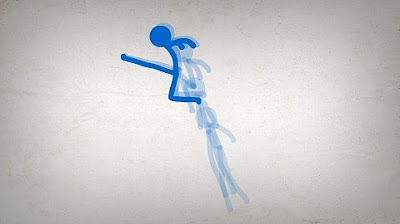Blocking Plus Workflow - Part 1 (Timing)
Summary
TLDRThe video discusses an animator's workflow for blocking animation, focusing on timing and spacing. The animator explains the process of refining character movement, particularly in terms of energy absorption, momentum, and timing of key poses. He emphasizes the importance of anticipation, how small adjustments can significantly affect the overall feel, and how to strike a balance between fast and slow movements. By experimenting with frame timing and spacing, the animator enhances the realism and dynamism of the character's actions, ensuring the animation feels natural and engaging.
Takeaways
- 🎥 The speaker explains their workflow for blocking animation, focusing first on spacing, not timing.
- 🔄 Spacing is the relationship between poses, helping to understand the movement and arc of the character.
- ⏲️ Timing is adjusted after blocking to create a smoother, more natural motion for the character.
- 💡 The speaker emphasizes that stopping motion takes more time than anticipated, allowing room to absorb energy.
- ⚖️ Balance between fast and slow motions is essential for creating a realistic flow in the character's movement.
- ✋ The anticipation of an action, like a jump, should have enough frames to clearly show energy buildup before the action.
- 🚶♂️ Hang time is introduced in jumps to emphasize the weight of the character, even if it risks looking cartoony.
- 📊 The speaker frequently refines timing by adding or removing frames, aiming for an interesting flow in the animation.
- 🧠 The audience needs time to register changes in the scene, with around 5-7 frames for the brain to process actions.
- 🎬 Varied timing between actions keeps the phrasing of the animation interesting, avoiding a monotonous flow.
Q & A
What is the speaker’s main focus during the blocking phase of animation?
-During the blocking phase, the speaker focuses on the spacing of the animation, which involves understanding the relationship between the poses. Timing is not the main concern at this stage.
Why does the speaker emphasize the need for additional steps when absorbing momentum?
-The speaker explains that when animating a character coming to a stop, additional steps are often required to make the movement feel realistic, as it takes more time to absorb momentum than initially expected.
How does the speaker approach the timing of the animation after blocking is complete?
-The speaker refines the timing by trial and error, adjusting frame counts to ensure the character's movements look natural. They have an idea of how long the poses should last but refine it during the process.
Why is anticipation important in animation, according to the speaker?
-Anticipation is crucial because it builds energy and sets up the audience to understand the upcoming action. It needs more frames than the jump itself to ensure the movement is clear and feels impactful.
How many frames does the speaker suggest the audience needs to register the setting and action?
-The speaker suggests that the audience needs about five to seven frames to register the setting, the character, and the action before major changes in the scene.
What is the speaker's approach to creating hang time during a jump?
-The speaker adds extra frames during the apex of the jump to create a feeling of hang time. This helps to convey weight and realism to the character's movement before they descend quickly.
Why does the speaker emphasize uneven timing in the animation?
-Uneven timing, where there are different gaps between actions, makes the phrasing of the animation more interesting. It prevents the animation from feeling monotonous and enhances the sense of realism.
What does the speaker mean by 'clearing up' an action?
-'Clearing up' an action refers to adding or adjusting frames to ensure the movement reads clearly to the audience, avoiding overly fast or abrupt transitions that might confuse the viewer.
How does the speaker use the red lines on the timeline to evaluate the animation?
-The speaker uses the red lines on the timeline to visually assess the spacing between actions. If the lines show varying gaps, it indicates that the timing is dynamic and not too uniform, which is desirable.
What role does trial and error play in the speaker’s animation workflow?
-Trial and error is central to the speaker's workflow, especially in the timing phase. They experiment with different frame counts and observe how it affects the weight and flow of the character’s movements, adjusting as needed.
Outlines

This section is available to paid users only. Please upgrade to access this part.
Upgrade NowMindmap

This section is available to paid users only. Please upgrade to access this part.
Upgrade NowKeywords

This section is available to paid users only. Please upgrade to access this part.
Upgrade NowHighlights

This section is available to paid users only. Please upgrade to access this part.
Upgrade NowTranscripts

This section is available to paid users only. Please upgrade to access this part.
Upgrade NowBrowse More Related Video

The Three Biggest Ideas in Animation

Don`t fall for this classic mistake (animation tutorial)

DASAR ANIMASI untuk Kelas XI Multimedia | Annas Nur Aziz | #vlogngajar #2

Tutorial 3D Animating (Karakter) untuk Pemula (Maya 3D) Bahasa Indonesia | Workflow dasar

ALAN BECKER - Stick Figure Animation (revamped)

Manual Routing in Vivado
5.0 / 5 (0 votes)